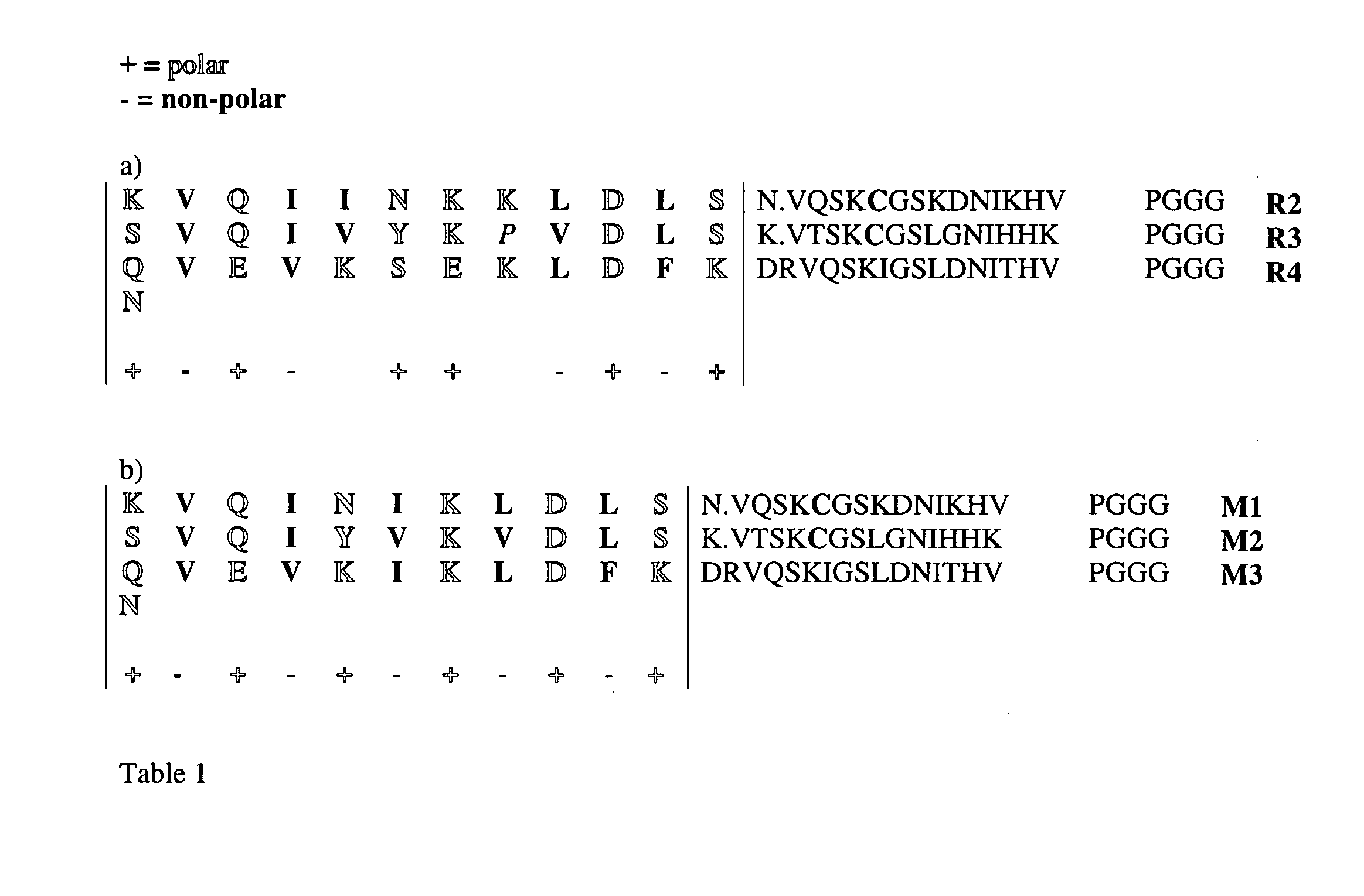Cellular model of tauopathies for lead identification and drug discovery
- Summary
- Abstract
- Description
- Claims
- Application Information
AI Technical Summary
Benefits of technology
Problems solved by technology
Method used
Image
Examples
example 1
Designed Tau Mutants
[0133]We have noted that the amino-acids in the microtubule-binding repeats form an incomplete, alternating pattern of polar and apolar residues (Table 1a). Nature seems to avoid complete alternating patterns of polar and non-polar amino acids, as a screen of all known sequences for proteins shows the least prevalence for sequences of this sort (Broome and Hecht (2000) J. Mol. Biol. 296, 961-968). West et al. (1999) Proc. Natl. Acad. Sci. USA 96, 11211-11216 and Wang et al. (2002) Proc. Natl. Acad. Sci. USA 99, 2760-2765 have shown that isolated peptides consisting of complete alternating patterns of polar and non-polar amino acids spontaneously form n-sheet fibrils similar to amyloid fibrils. Neurofibrillary tangles were not addressed in these publications.
[0134]Based on the available pattern in the first three microtubule-binding domains, we have introduced complete alternating pattern of at least 5, and in case of the experiments shown 11 polar and apolar resi...
example 2
Aggregation and FRAP in CHO Cells
[0139]Following Effectene-based plasmid DNA transfection with a triple mutant (M123) in CHO cells, formation of morphologically apparent aggregates was observed, while wild-type tau showed normal MT (microtubule) association without aggregates. M2 showed some increased aggregation. 24 hrs post transfection, 3 types of aggregates (FIG. 2a) were visible in double and triple mutant cells, namely: 1. punctate microaggregates (variant 1) 2. bulky aggregates (oval or submembranous ring-like) (variant 2) 3. granular cytosolic accumulation (variant 3) The same picture was observed with the double mutants, but not with wild-type tau (FIG. 2b). Wild-type tau associated with microtubules, while aggregating mutant cells showed no overlap between aggregates and the tubulin cytoskeleton (FIG. 2c). On the contrary—in areas with bulky aggregation a deficit of the normal cytoskeletal configuration was observed. In order to visualize a difference in the biophysical pr...
example 3
Toxicity and Phosphorylation-Directed Immunocytochemistry in Human SHSY5Y Neuroblastoma Cells
[0142]In order to examine the neurotoxicity of the mutant tau variants in human neuronal cell line, SHSY5Y neuroblastomas were used and the cell number of each preparation at 48 and 72 hours post transfection was normalized to the cell number in the same dish at 24 hours. The triple mutant exerted a strong neurotoxicity at 72 h. post transfection, as this effect was already obvious at 48 h. post transfection (FIG. 4a). The same effect was observed by the double mutants. Further, the presence of two specific pathological phosphoepitopes was tested using phosphospecific antibodies—AT8 (S202 / T205 specific) and AT100 (T212 / S214), the latter being exclusively specific for Alzheimer's disease NFTs and generally considered as the only AD-specific antibody by experts in the field of neuropathology. Although described as being slightly phosphorylated in mitotically active cells like CHO cells and LAN...
PUM
| Property | Measurement | Unit |
|---|---|---|
| Fraction | aaaaa | aaaaa |
| Polarity | aaaaa | aaaaa |
| Flexibility | aaaaa | aaaaa |
Abstract
Description
Claims
Application Information
 Login to View More
Login to View More - R&D
- Intellectual Property
- Life Sciences
- Materials
- Tech Scout
- Unparalleled Data Quality
- Higher Quality Content
- 60% Fewer Hallucinations
Browse by: Latest US Patents, China's latest patents, Technical Efficacy Thesaurus, Application Domain, Technology Topic, Popular Technical Reports.
© 2025 PatSnap. All rights reserved.Legal|Privacy policy|Modern Slavery Act Transparency Statement|Sitemap|About US| Contact US: help@patsnap.com



